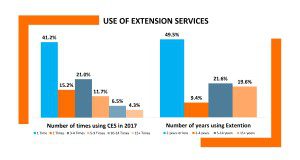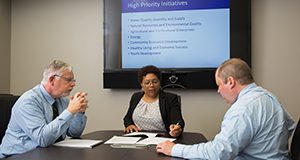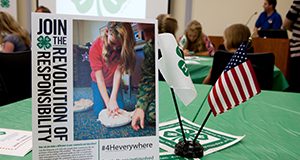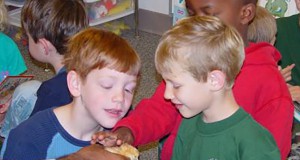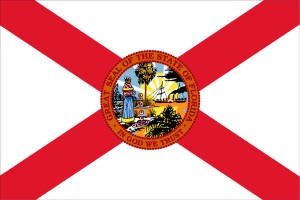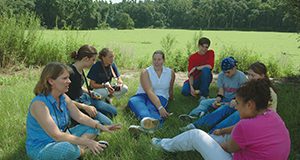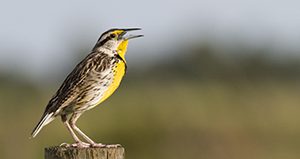While the desire to implement urban agriculture projects is growing in popularity, there is little information available to help Extension agents and interested citizens fully understand how to implement urban agriculture in their community. This new 11-page document provides an overview of key information required to establish an urban agriculture ordinance. Case studies from urban agriculture initiatives in Florida provide real-world examples of the required activities, potential challenges, and beneficial partners for implementing these initiatives. Resources related to the case studies and additional urban agriculture resources can be found at the end of the document, so that readers can find further information specific to their interests and needs. Written by Candace A. Spencer, Catherine G. Campbell, Anna Prizzia, and Liz Felter, and published by the UF/IFAS Horticultural Sciences Department.
http://edis.ifas.ufl.edu/hs1327
Category: Community Development
Clients’ Experience with FCES: Widespread Satisfaction Tempered with Suggestions for Improvement
The Florida Cooperative Extension Service (FCES) provides a variety of information to clients throughout the state. In order to determine the extent of client satisfaction, the FCES conducts an annual survey. The survey was sent to a sample of clients who have received educational information between March and July, 2017. A total of 1,202 participants responded, and 94.9% of Extension clients reported that they were satisfied or very satisfied with the overall services provided. Many Extension clients also shared suggestions for improving services, including improved communication, increased advertising, and increased availability for some classes. In this five-page document from the UF/IFAS Department of Agricultural Education and Communication, Glenn D. Israel and Tiffany Henderson summarize the results of the survey and provide recommendations for how to improve Extension’s services.
http://edis.ifas.ufl.edu/wc326
Enhancing Motivation through Work Meaningfulness
Work meaningfulness is described as the amount of significance an employee perceives in their work. Employees who view their work as meaningful demonstrate higher work motivation, performance, and satisfaction than employees who do not. This new 2-page document discusses ways to change the perception of meaningful work. Written by Jarred A. Shellhouse, Hannah S. Carter, and Matt P. Benge, and published by the UF/IFAS Department of Agricultural Education and Communication, February 2019.
http://edis.ifas.ufl.edu/wc330
Florida 4-H Community Pride Leader’s Guide
Service learning is an important component of youth development because it allows youth to strengthen their critical thinking skills, leadership skills, and civic and social responsibility. This 5-page Leader's Guide will help you and your club members get the most out of the Community Pride Program. Written by Stacey Ellison and Grace Carter, and published by the UF/IFAS 4-H Youth Development Department, January 2019.
http://edis.ifas.ufl.edu/4h396
School-Based 4-H Programming: Getting Started
School-based programs provide an opportunity to youth who would not be able to participate in traditional 4-H club offerings otherwise. If you want to expand your 4-H program in diversity, subject matter, and/or number of youth reached, school-based programming may be the solution for you. This 6-page document discusses school-based programs, differences between school-based programming and traditional club programming, reasons to start school-based programs, ways to work with school sites, and enrollment for school-based program youth. It is part of the 4-H 101 Fact Sheet series. Written by Vanessa Spero-Swingle and Susan Munyan, and published by the UF/IFAS 4-H Youth Development Department, April 2018.
http://edis.ifas.ufl.edu/4h389
Developing and Strengthening Networks to Promote Resilience After Disasters
The HGHC series includes thirteen publications that focus on the work of the community outreach and dissemination team, including community engagement, outreach, and research result dissemination. This 3-page document focuses on developing and strengthening networks before they are challenged to promote resilience in and after a disaster. Written by Angela B. Lindsey, Samantha Goldenberg, and Cassie Wandersee, and published by the UF/IFAS Department of Family, Youth and Community Sciences, April 2018.
http://edis.ifas.ufl.edu/fy1477
How Likely Is a 100-Year Rainfall Event During the Next Ten Years?
This 4-page fact sheet describes proper interpretation of rainfall event probabilities and recurrence intervals, particularly as they are used by engineers and water resources managers in the design and construction of hydraulic structures, such as dams, levees, and canals. This article focuses on rainfall, but its explanations and concepts can be applied to other extreme hydrologic phenomena such as flood and drought. Written by Young Gu Her, William Lusher, and Kati Migliaccio, and published by the UF/IFAS Department of Agricultural and Biological Engineering, March 2018.
http://edis.ifas.ufl.edu/ae523
Recruiting and Retaining Members in Agricultural Organizations
Many organizations struggle with recruiting new members and retaining current members. The UF/IFAS PIE Center conducted membership surveys of the Florida Cattlemen’s Association and Florida CattleWomen to aid both groups in their membership efforts. This 3-page document discusses common membership barriers and practices in order to help agricultural organizations be better equipped to attract new members and keep current ones. Written by Ricky Telg and published by the UF/IFAS Department of Agricultural Education and Communication, March 2018.
http://edis.ifas.ufl.edu/wc300
Public Policy Issues in Florida: 2017-18 Constitution Revision Commission (CRC)
It is an exciting time in Florida public policy; the once-in-every-two-decades Constitution Revision Commission is in the process of recommending changes to the Florida state constitution. This 4-page fact sheet written by Rodney L. Clouser and published by the UF/IFAS Food and Resource Economics Department describes the process and explains how to get involved, evaluate the proposals for changes to the constitution, and cast an informed vote in November 2018.
http://edis.ifas.ufl.edu/fe1035
Important Resources for the Development and Sustainability of School Garden Programs
Extension agents serve as a valuable resource in providing teachers with in-service training and technical education to increase their ability to effectively use gardening as an instructional tool. This three-page document provides an outline of important resources to help in the development and sustainability of a school garden program. Written by John M. Diaz and Erin Elsberry and published by the Department of Agricultural Education and Communication.
http://edis.ifas.ufl.edu/wc283
Reframing Leadership
Effective leadership is essential in the businesses where we work, the institutions where we learn and in the communities where we live. Our own leadership is a product of how we see the world. This three-page article looks at Bolman and Deal’s book Reframing Organizations and the different frames to address organizational issues and leadership. Written by Matthew Sowcik, Hannah Carter, and Valerie McKee and published by the Department of Agricultural Education and Communication.
http://edis.ifas.ufl.edu/wc284
Getting Engaged: Resources to Support Community Engagement Practices
This document is part of a series called Getting Engaged (http://edis.ifas.ufl.edu/topic_series_getting_engaged), designed to help Extension and research faculty and other community engagement professionals improve their engagement with a variety of stakeholder audiences. This four-page document offers resources for practitioners at all stages, from those just beginning to think about engagement to those who have been engaging their communities for years. Written by Kathryn A. Stofer and published by the Department of Agricultural Education and Communication.
http://edis.ifas.ufl/edu/wc273
Developing County Associations for School and Community Gardens
Increasingly, gardeners receive attention for the educational, environmental, health, and social impacts that their projects facilitate within schools and communities. Garden associations allow Extension to play a vital role in providing technical information to support new and existing gardens. This three-page fact sheet outlines the framework used by a pilot garden association program in Polk County, Florida. Written by John M. Diaz, Susan Tyler Webb, and Erin Elsberry and published by the Department of Agriculture Education and Communication.
http://edis.ifas.ufl.edu/wc279
Getting Engaged: Public Engagement Practices for Researchers
A part of the Getting Engaged series that aims to help readers become more comfortable with engaging various stakeholder audiences, this five-page fact sheet is designed for agriscience, natural resources, or other science and engineering faculty with primarily natural or physical science backgrounds who want to get started in stakeholder engagement. Written by Kathryn A. Stofer and published by the Department of Agricultural Education and Communication.
http://edis.ifas.ufl.edu/wc272
Effective Practice for Building Cross Sector Partnerships
This four-page article outlines a practical framework built upon best practices that can be used by those considering the development of cross sector partnerships to address environmental and social issues.Written by John M. Diaz and published by the Department of Agricultural Education and Communication.
http://edis.ifas.ufl.edu/wc271
Building for Birds Evaluation Tool: Breeding and Wintering Habitat for Forest Birds
Several bird species use forest fragments and trees conserved in built areas as breeding, wintering, and stopover habitat. Scientists have created a Building for Birds online tool to help these birds and the people who appreciate them. This evaluation tool is most useful for small developments or developments in already fragmented landscapes.
The tool is designed for use when no opportunity is available to conserve large forest areas of 125 acres or more within a proposed development. Developers are sometimes reluctant to conserve trees and forest fragments in subdivided residential/commercial areas because it costs time and money, but there is value in this conservation effort not only for many different species of forest birds, but for future homeowners waking to birdsong in the mornings.
This 17-page fact sheet written by Mark Hostetler and Jan-Michael Archer and published by the Department of Wildlife Ecology and Conservation describes the online tool and shows how it can help preserve breeding and wintering habitat for migrating birds.
http://edis.ifas.ufl.edu/uw417
Building for Birds Evaluation Tool: Forest Fragments Used as Stopover Sites by Migrant Birds
Several bird species use forest fragments and trees conserved in built areas as breeding, wintering, and stopover habitat. Scientists have created a Building for Birds online tool to help these birds and the people who appreciate them. This evaluation tool is most useful for small developments or developments in already fragmented landscapes.
The tool is designed for use when no opportunity is available to conserve large forest areas of 125 acres or more within a proposed development. Developers are sometimes reluctant to conserve trees and forest fragments in subdivided residential/commercial areas because it costs time and money, but there is value in this conservation effort not only for many different species of forest birds, but for future homeowners waking to birdsong in the mornings.
This 18-page fact sheet written by Mark Hostetler and Jan-Michael Archer and published by the Department of Wildlife Ecology and Conservation describes the online tool and shows how it can help preserve stopover habitat for migrating birds.
http://edis.ifas.ufl.edu/uw416
Starting a Community Garden
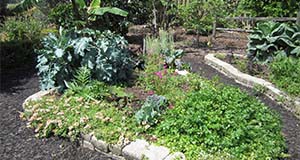
A community garden is a great way to unite a group of people in a common goal. In addition to providing fresh herbs, vegetables, and fruit, community gardens can also increase self-esteem, beautify a neighborhood, and create and opportunity for socializing and improving health. This four-page fact sheet outlines the importance of community gardens and how to develop and manage a community garden. Written by Adrian Hunsberger, Eva C. Worden, and John McLaughlin, and published by the Environmental Horticulture Department.
http://edis.ifas.ufl.edu/ep124
How the General Public and Local Officials Prefer to Learn about Agricultural Water Use in Florida
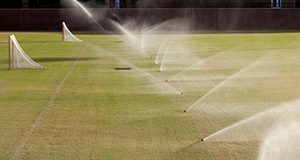
Water is a precious resource that is invaluable to the state of Florida. The amount of water being used daily in the state is estimated at 14.3 million gallons. Part of a series dedicated to describing the preferred ways of learning about agricultural water use in Florida, this study can be used to assist Extension educators and the agricultural industry at large in the development of strategies meant to inform people about the realities of water use. This three-page fact sheet helps Extension educators understand preferred learning mediums so they can provide useful information about agricultural water use. Written by Courtney T. Owens, Alexa J. Lamm, and Ricky W. Telg and published by the Agricultural Education and Communication Department.
http://edis.ifas.ufl.edu/wc247
Conservation Subdivision: Post-construction Phase: Creating Signs to Educate Residents
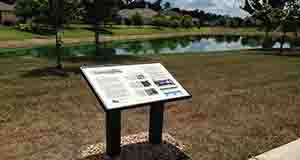
Installing educational signs is one way to increase awareness and participation in conservation activities. This six-page fact sheet written by Mark Hostetler and published by the Department of Wildlife Ecology and Conservation explains how to create educational signs and install them in residential neighborhoods as a way to inform residents about biodiversity conservation. The fact sheet, one of the UF/IFAS Conservation Subdivision series, explains how to design effective signs, how to manage a series of signs to keep the information fresh, and how to maintain the signs to ensure that residents and visitors to the community continue to benefit and maintain their homes, yards, and neighborhoods sustainably for years to come.
http://edis.ifas.ufl.edu/uw407

